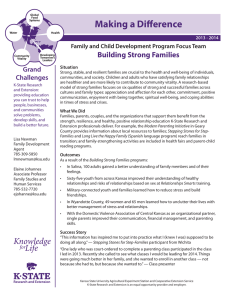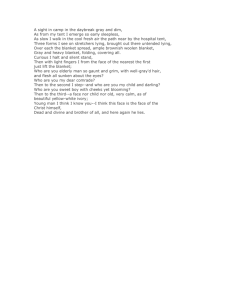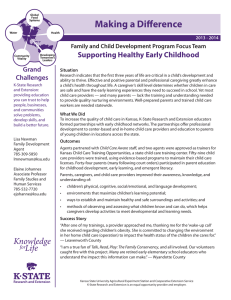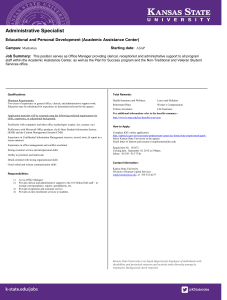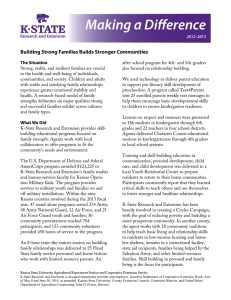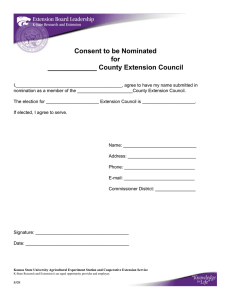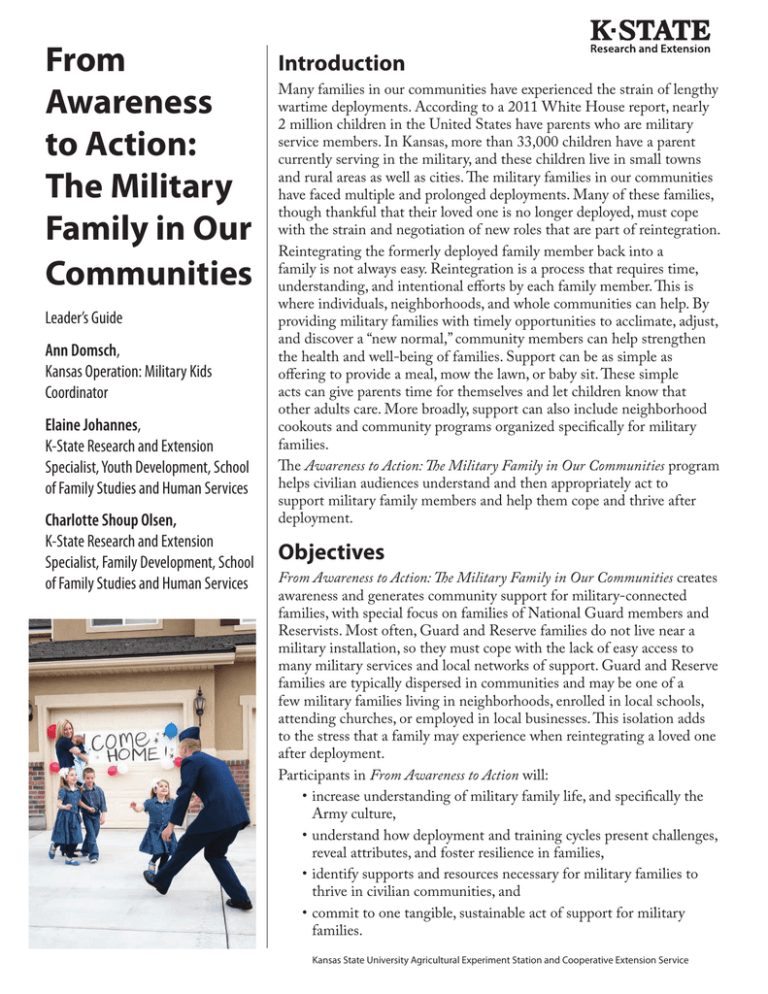
From
Awareness
to Action:
The Military
Family in Our
Communities
Leader’s Guide
Ann Domsch,
Kansas Operation: Military Kids
Coordinator
Elaine Johannes,
K-State Research and Extension
Specialist, Youth Development, School
of Family Studies and Human Services
Charlotte Shoup Olsen,
K-State Research and Extension
Specialist, Family Development, School
of Family Studies and Human Services
Introduction
Many families in our communities have experienced the strain of lengthy
wartime deployments. According to a 2011 White House report, nearly
2 million children in the United States have parents who are military
service members. In Kansas, more than 33,000 children have a parent
currently serving in the military, and these children live in small towns
and rural areas as well as cities. The military families in our communities
have faced multiple and prolonged deployments. Many of these families,
though thankful that their loved one is no longer deployed, must cope
with the strain and negotiation of new roles that are part of reintegration.
Reintegrating the formerly deployed family member back into a
family is not always easy. Reintegration is a process that requires time,
understanding, and intentional efforts by each family member. This is
where individuals, neighborhoods, and whole communities can help. By
providing military families with timely opportunities to acclimate, adjust,
and discover a “new normal,” community members can help strengthen
the health and well-being of families. Support can be as simple as
offering to provide a meal, mow the lawn, or baby sit. These simple
acts can give parents time for themselves and let children know that
other adults care. More broadly, support can also include neighborhood
cookouts and community programs organized specifically for military
families.
The Awareness to Action: The Military Family in Our Communities program
helps civilian audiences understand and then appropriately act to
support military family members and help them cope and thrive after
deployment.
Objectives
From Awareness to Action: The Military Family in Our Communities creates
awareness and generates community support for military-connected
families, with special focus on families of National Guard members and
Reservists. Most often, Guard and Reserve families do not live near a
military installation, so they must cope with the lack of easy access to
many military services and local networks of support. Guard and Reserve
families are typically dispersed in communities and may be one of a
few military families living in neighborhoods, enrolled in local schools,
attending churches, or employed in local businesses. This isolation adds
to the stress that a family may experience when reintegrating a loved one
after deployment.
Participants in From Awareness to Action will:
•increase understanding of military family life, and specifically the
Army culture,
•understand how deployment and training cycles present challenges,
reveal attributes, and foster resilience in families,
•identify supports and resources necessary for military families to
thrive in civilian communities, and
•commit to one tangible, sustainable act of support for military
families.
Kansas State University Agricultural Experiment Station and Cooperative Extension Service
Ideas for Community Activities
•Plant “Welcome Home” and “Thank You” gardens and trees.
•Hold child care trainings for teens.
•Ask military families to identify what they need and want.
•Volunteer to babysit so parents can have time together.
•Help with (outside, inside) household chores.
•Offer to read to children while parents have some alone time.
•Purchase books for school libraries about the military family
experience.
•Volunteer to run errands.
•Drop off a home-cooked meal.
•Teach board games at a family game night sponsored by the local
K-State Research and Extension office.
•Listen to military-connected youth.
•Produce a play by military-connected youth.
•Connect families to helpful community organizations.
•Provide opportunities for military families to strengthen
communication and connections.
•Invite family members to take walks.
Suggested Presentation Format
Before you Begin
•Invite military participants and a co-facilitator with military
experience.
•Have copies of handouts, evaluation form, and local resources for
participants.
•Download the PowerPoint presentation from www.ksre.ksu.edu/
families, should you choose to use it.
•Provide newsprint, flip chart, and markers to record ideas for
community efforts.
•Provide healthy refreshments — food always makes people more
comfortable and more attentive.
Presentation (approximately 1 hour)
•5 minutes — Welcome and introductions. If time permits, facilitate
“A Blanket Community” activity (on next page) to build rapport.
•2 minutes — Introduce the topic by covering the Introduction and
lesson objectives (see previous page).
•15 minutes — Use the PowerPoint program from the K-State
Research and Extension “Families!” website or design your own.
•15 minutes — Facilitate a discussion of how participants and the
community could support military families. Encourage questions
and reflection. Move the discussion toward two or three ideas.
Reflect on the list of ideas from the participant handout. Write
Resources With
More Information
1. Military Home Front),
www.militaryhomefront.dod.mil
2. Military OneSource — online, phone
and face-to-face counseling for military
families, www.militaryonesource.com
3. Military Child Education Coalition
www.militarychild.org
4. Operation: Military Kids
www.operationmilitarykids.org
5. Strengthening our Military Families,
White House report, January 2011,
www.defense.gov/home/
features/2011/0111_initiative/
strengthening_our_military_
january_2011.pdf
6. MacDermid, S.M., Samper, R., Schwarz,
R., Nischida J., & Nyaronga, D., (2008)
Understanding and Promoting Resilience
in Military Families, Military Family
Research Institute, Purdue University,
www.cfs.purdue.edu/MFRI/resources/
public/reports/Understanding%20
and%20Promoting%20Resilience.pdf
Take the Activity a Step
Further
Have three or four people hold the blanket
as the group discusses what happens when
soldiers return after deployment. Everyone
now picks up the blanket, but in different
locations. The “blanket” is back, but it is now
different. The dentist who was deployed
is back to work, but is missing a leg. Your
neighbor is home, but no longer likes to go
hunting and doesn’t like to be in crowds.
His daughter says that he has PTSD (posttraumatic stress disorder).
Ask Participants:
1. How might you feel about this person
being added back into the community?
2. Now that service members are home, can
we stop helping military families?
3. Due to these changes, how might a
community member help these families?
ideas, action steps, and possible responsibilities on the newsprint
or flip chart so the group sees the tangible acts that resulted from
their awareness. Ask a key participant to follow up with volunteers
to implement any of the ideas. Collect that key participant’s contact
information and send that information along with the evaluations to
Elaine Johannes (see below).
•2 minutes — Thank the participants (especially those who are
military connected) and ask that all complete and return the
“Awareness to Action” evaluation form.
Evaluation
Send the completed forms and contact information of key participant* to:
Awareness to Action c/o Elaine Johannes
Kansas State University
School of Family Studies and Human Services
343 Justin
Manhattan, KS 66506
*Within three months, the key participant will receive a follow-up email or
phone call from Elaine Johannes inquiring about any community actions
resulting from the program.
Activity: A Blanket Community
Supplies
•Blanket, tarp, or tablecloth
•Several objects to represent various aspects of the community such
as balls, empty plastic water bottles, other objects with different
shapes and textures.
The Activity
Place the blanket or tarp on the floor and have all participants align
themselves on the edges. Each member picks up an edge of the cloth and
holds the blanket tightly. Add objects to the center of the blanket. Each
participant holding the blanket will assume a community role: teacher,
parent, business owner, law enforcement officer, doctor, county employee,
school administrator, elected official, or other community member.
Add the objects and tell the group that these are the children in our
community, and that we have to keep them safe. Have the group make
a wave with the blanket but at the same time keep the children on the
blanket. Begin telling the group that the business owner, a member of the
National Guard has been deployed. That person drops out; then call more
people to be deployed until you are down to two or three people.
Reflection — Ask Participants
1. What happened as people started leaving their spots on the blanket?
2. How did you feel in trying to keep all the objects on the blanket?
3. How did your role/responsibility change as others left the blanket?
4. What implications does this activity have for how we respond to the
military youth and families in our community?
Contact Information
Ann Domsch
Coordinator
Kansas Operation: Military Kids
785-532-2276
adomsch@ksu.edu
www.operationmilitarykids.org
Elaine Johannes, Ph.D.
Associate Professor and Extension Specialist
– Youth Development
School of Family Studies and Human Services
785-532-7720
ejohanne@ksu.edu
Charlotte Shoup Olsen, Ph.D.
Professor and Extension Specialist – Family
Development
School of Family Studies and Human Services
785-532-5773
colsen@ksu.edu
Reviewers
Darrin Allen, 4-H/Army Youth Development
Project
Marlene Glasscock, 4-H/Army Youth
Development Project
Mona Johnson, Washington State Office of
Superintendent of Public Instruction
Sarah Jones, (former) Army Reserve Child &
Youth Services
Frances Swenson, Kansas American Legion
Jennifer Barter, intern/practicum student,
University of Southern Mississippi.
From Awareness to Action: the Military Family in
Our Communities — Evaluation Form
Your comments about “Awareness to Action” are important. Please complete
this form and return it to your leader. There is space on the back of this form
for additional remarks and suggestions. Thank you.
Training Date: _____________Trainer’s Name: ________________________
Training Location: _______________________________________________
Organization sponsoring the training: _______________________________
Knowledge of military
culture
Knowledge of military
family challenges and
strengths
Knowledge of ways
communities can support
military families
Motivation to support military youth and families
Circle your skill level
Circle your skill level
or knowledge
or knowledge
BEFORE the training
AFTER the training
Very little
A lot Very little
A lot
1 2 3 4 5
1 2 3 4 5
1
2
3
4
5
1
2
3
4
5
1
2
3
4
5
1
2
3
4
5
1
2
3
4
5
1
2
3
4
5
List the most important thing that you gained from “Awareness to Action”:
List one tangible, sustainable act you can do to support military families in
your community:
Circle the number that best reflects how worthwhile this training was to you.
1
2
3
4
5
Not worthwhile
Somewhat worthwhile
Very worthwhile
Optional
Your name: ________________________
Your email and/or phone number: _______________________________
Brand names appearing in this publication are for product identification purposes only.
No endorsement is intended, nor is criticism implied of similar products not mentioned.
Publications from Kansas State University are available at: www.ksre.ksu.edu
Publications are reviewed or revised annually by appropriate faculty to reflect current research and practice. Date shown is that of
publication or last revision. Contents of this publication may be freely reproduced for educational purposes. All other rights reserved.
In each case, credit Ann Domsch, Elaine Johannes, Ph.D., and Charlotte Shoup Olsen, Ph.D., Awareness to Action: The Military Family
in our Communities, Leader’s Guide, Kansas State University, August 2012.
Kansas State University Agricultural Experiment Station and Cooperative Extension Service
MF3063
August 2012
K-State Research and Extension is an equal opportunity provider and employer. Issued in furtherance of Cooperative Extension Work, Acts of May 8 and June 30, 1914,
as amended. Kansas State University, County Extension Councils, Extension Districts, and United States Department of Agriculture Cooperating, John D. Floros, Director.

